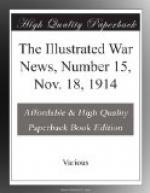One of the curious fictions about England now going round in Germany is one that Sir John Jellicoe’s fleet keeps in hiding lest it should meet the German fleet. German war-ships, indeed, scour the North Sea at all hours to give the Grand Fleet battle! Our illustration, from a serious painting published in a German paper, shows them at it.
_______________________________________________________
___________________ The illustrated war news, Nov. 18, 1914—29
[Illustration: Telling the tale in Germany!—A German battle-picture showing Prince Heinrich of Bavaria leading A cavalry assault.]
Early in the war, the Kaiser commissioned various painters to produce battle-pictures of German prowess. The royal house of Bavaria has apparently followed suit. More recently the Kaiser expressed a wish that the British might meet the Bavarians “just once” and his wish was gratified. In depicting a Bavarian cavalry fight with French dragoons, the Bavarian artist naturally represents the enemy as going down like nine-pins. Prince Heinrich, who figures in the drawing, is the only son of the late Prince Francis Joseph of Bavaria, first cousin of Prince Rupprecht, the Bavarian Crown Prince, who recently exhorted his troops to conquer “our most hated foe.” He also highly extolled the Bavarian cavalry, who, he said, have fought “with the greatest fearlessness and extraordinary dash.”
_______________________________________________________
___________________ 30—The illustrated war news, Nov. 18, 1914.
[Illustration: Germany’s Eastern Stronghold which suffered the fate of liege and Antwerp: Men of the German garrison at Tsing-tau.]
It is said that the German garrison at Tsing-tau, which surrendered to the Japanese and British on November 7, included five battalions of infantry, fire battalions of marine artillery, one battalion of mechanics, and about 2500 reservists. After the surrender of the garrison a number of German soldiers are said to have escaped in native boats, but were recaptured. The defences were under naval control. Tsing-tau was strongly fortified and had about 600 Krupp guns of various calibre. The photographs show men of the Third Sea Battalion. (1) On the march in Tsing-tau; (2) and (3) Entrenched with a machine-gun. Our correspondent states that the photographs were taken since the siege began; otherwise the dark band round the helmet-covers might be taken for a manoeuvres badge.
_______________________________________________________
___________________ The illustrated war news, Nov. 18, 1914—31
[Illustration: Some of the 2500 Germans captured at Tsing-tau: Men of the third sea battalion with A machine-gun during the siege.]




